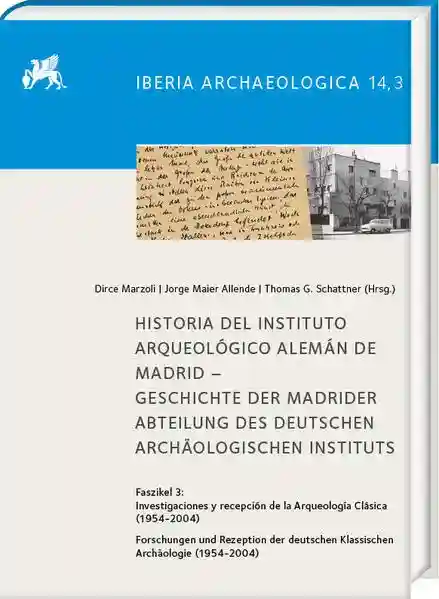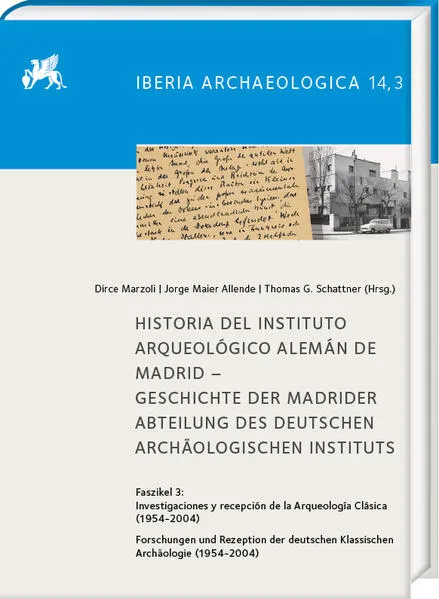Iberia Archaeologica
Historia del Instituto Arqueológico Alemán de Madrid.Geschichte der Madrider Abteilung des Deutschen Archäologischen Instituts
Chronologie aller Bände (1 - 2)

Die Reihenfolge beginnt mit dem Buch "Historia del Instituto Arqueológico Alemán de Madrid.Geschichte der Madrider Abteilung des Deutschen Archäologischen Instituts". Wer alle Bücher der Reihe nach lesen möchte, sollte mit diesem Band von Dirce Marzoli beginnen. Die Reihe umfasst derzeit 2 Bände. Der neueste Band trägt den Titel "Explaining the Urban Boom".
- Anzahl der Bewertungen für die gesamte Reihe: 0
- Ø Bewertung der Reihe: 0
Diese Reihenfolge enthält 2 unterschiedliche Autoren.
- Band: 14
- Autor: Marzoli, Dirce
- Anzahl Bewertungen: 0
- Ø Bewertung:
- Medium: Buch
- Veröffentlicht: 22.11.2023
- Genre: Sonstiges
Historia del Instituto Arqueológico Alemán de Madrid.Geschichte der Madrider Abteilung des Deutschen Archäologischen Instituts
Wie die anderen Abteilungen des Deutschen Archäologischen Institutes (DAI), so kann auch die Madrider Abteilung auf eine lange Geschichte zurückblicken. Sie besteht seit einem dreiviertel Jahrhundert, Zeit also um den balancierenden Rückblick zu wagen, die geleistete Arbeit kritisch Revue passieren zu lassen. Die Beschäftigung erfolgt im Rahmen eines Großprojektes zur Forschungsgeschichte des gesamten DAI. Ziel ist es, den Werdegang der Abteilungen in ihrer jeweiligen geschichtlichen Stellung zu beleuchten. Die Madrider Abteilung wählt dafür einen eigenen Weg. Sie stellt ihre Forschungsgeschichte aus der Perspektive der Gastländer Spanien, Portugal und Marokko dar. Die Außenwahrnehmung spiegelt damit nicht allein die Forschungsgeschichte der Auslandsabteilung wider, sondern auch die der Gastländer.
Al igual que los demás departamentos del Instituto Arqueológico Alemán (IAA), el de Madrid tiene una larga historia, que comprende ya tres cuartos de siglo. Este periodo de tiempo nos permite hacer un análisis retrospectivo equilibrado en el que se revisa críticamente el trabajo realizado. La obra forma parte de un importante proyecto sobre la historia de la investigación del Instituto. El principal objetivo es arrojar luz sobre el desarrollo de los departamentos desde un punto de vista histórico. Para ello, el departamento de Madrid ha diseñado una vía propia presentando su historia desde la perspectiva de los países anfitriones, España, Portugal y Marruecos. La percepción externa no refleja solamente la historia interna del departamento del IAA, sino también la de los propios países anfitriones.
Al igual que los demás departamentos del Instituto Arqueológico Alemán (IAA), el de Madrid tiene una larga historia, que comprende ya tres cuartos de siglo. Este periodo de tiempo nos permite hacer un análisis retrospectivo equilibrado en el que se revisa críticamente el trabajo realizado. La obra forma parte de un importante proyecto sobre la historia de la investigación del Instituto. El principal objetivo es arrojar luz sobre el desarrollo de los departamentos desde un punto de vista histórico. Para ello, el departamento de Madrid ha diseñado una vía propia presentando su historia desde la perspectiva de los países anfitriones, España, Portugal y Marruecos. La percepción externa no refleja solamente la historia interna del departamento del IAA, sino también la de los propios países anfitriones.
- Band: 22
- Autor: Lehmann, Janine
- Anzahl Bewertungen: 0
- Ø Bewertung:
- Medium: Buch
- Veröffentlicht: 06.12.2023
- Genre: Roman
Explaining the Urban Boom
North Africa and the Iberian Peninsula were both key geographical regions in the Roman world. Their resources, elites, and culture were important factors in the development and growth of the Roman empire. Both regions experienced an Urban Boom in the imperial period and, as a result, the modern countries of Spain, Portugal, Morocco, Algeria, Tunisia, and Libya all possess remains of significant numbers of settlements with impressively monumentalized cityscapes dating back to the Roman period. While this process of monumentalization took place in two very different parts of the empire, and peaked in prosperity at different times, some striking similarities in their paths to urban development can still be observed.
This volume is the result of an international workshop held at the German Archaeological Institute in Madrid in 2018. The workshop brought together historians, archaeologists, and epigraphists, asking them to reflect on the causal factors behind the various phenomena that constitute the Urban Boom in each of these regions. The chapters offered here constitute a significant contribution to the study of ancient urbanism, identifying some of the key elements that triggered urban development in the Roman empire. The variety of studies presented not only demonstrates the complexities involved in the study of the processes behind ancient urbanization – from the level of individual cities to broader settlement systems – it also sharpens our view of the urban achievements that were specific to the Roman period.
This volume is the result of an international workshop held at the German Archaeological Institute in Madrid in 2018. The workshop brought together historians, archaeologists, and epigraphists, asking them to reflect on the causal factors behind the various phenomena that constitute the Urban Boom in each of these regions. The chapters offered here constitute a significant contribution to the study of ancient urbanism, identifying some of the key elements that triggered urban development in the Roman empire. The variety of studies presented not only demonstrates the complexities involved in the study of the processes behind ancient urbanization – from the level of individual cities to broader settlement systems – it also sharpens our view of the urban achievements that were specific to the Roman period.

